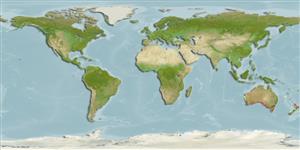>
Kurtiformes (Nurseryfishes, cardinalfishes.) >
Apogonidae (Cardinalfishes) > Apogoninae
Etymology: Siphamia: A Swazi word, siphama, for a fish.
More on author: Castelnau.
Environment: milieu / climate zone / depth range / distribution range
экология
морской; солоноватоводный донно-пелагический; пределы глубины 0 - 7 m (Ref. 57178). Temperate; 25°S - 45°S
Eastern Indian Ocean: endemic to southern Australia, from Shark Bay, Western Australia to Byron Bay, New South Wales.
Size / Вес / Возраст
Maturity: Lm ? range ? - ? cm
Max length : 5.0 cm SL самец/пол неопределен; (Ref. 26498)
Краткое описание
морфология | морфометрия
колючие лучи спинного плавника (общее число): 7; членистые (мягкие) лучи спинного плавника (общее число): 8; колючие лучи анального плавника 2; членистые (мягкие) лучи анального плавника: 8 - 9. This species is distinguished by the following characters: D1 VI, D2 I,8 (rarely 7 or 9 soft rays); A II,8-9; pectoral fin rays 12-14, unbranched and compressed distally; tubed lateral-line scales 22-23; median predorsal scales 4-5; total gill rakers 4-6 + 14-16, developed gill rakers 1-3 + 13-16 = 15-18; gill rakers on ceratobranchial 9-10; body relatively slender, depth 3.2-4.8 in SL, and body width 1.6-1.8 in the depth; eye diameter 3.2-3.7 in HL; first dorsal spine 1.1-1.3 in second spine; second dorsal spine 2.6-3.6, spine of second dorsal fin 5.1-6.7, and second anal spine 6.0-7.4, all in
head length (HL); pectoral-fin length 5.8-6.7 and pelvic-fin length 5.7-6.1 in SL; caudal-peduncle length 1.05-1.4 in distance between pelvic spine insertion and anal-fin origin; preopercular edge and ridge smooth, with the ventral edge weakly ossified and usually slightly crenulate; palatines with 1-3 series of small teeth; first infraorbital pore a complex of about 7 small pores; scales large, mostly ctenoid; tubed lateral-line scales with vertical series of papillae; the tip of light organ on each side of tongue bound by membrane (Ref. 90035).
Benthic species (Ref. 75154) which occurs over soft bottom in coastal embayments and in the lower reaches of estuaries (Ref. 33616). It is found usually in schools near kelp or seagrass beds of Zostera or Posidonia at depths of 1-10 m (Ref. 90035).
Life cycle and mating behavior
половая зрелость | размножение | нерест | икра | Fecundity | личинки
Mouthbrooders (Ref. 240). Distinct pairing during courtship and spawning (Ref. 205). Adults in South Australian waters have been observed brooding eggs in January (Ref. 33616).
Gon, O. and G.R. Allen, 2012. Revision of the Indo-Pacific cardinalfish genus Siphamia (Perciformes: Apogonidae). Zootaxa 3294:1-84. (Ref. 90035)
Статус Красного Списка МСОП (Ref. 130435)
Угроза для людей
Harmless
Использование человеком
дополнительная информация
Возраст/РазмерыростЗависимость между длиной и массой телаЗависимость между длинамиРазмерный составморфометрияморфологияличинкидинамика численности личинокпополнениечисленностьBRUVS
ссылкиаквакультура (рыбоводство)особенности рыбоводствастепень растяжениягенетикаElectrophoresesнаследуемостьболезниобработкаNutrientsMass conversion
соавторыизображенияStamps, Coins Misc.звукиCiguateraскоростьтип плаванияжаберная областьOtolithsмозгзрение
инструменты
Специальные отчеты
Скачать в формате XML
ресурсы в Интернет
Estimates based on models
Preferred temperature (Ref.
123201): 15.3 - 22, mean 17.8 °C (based on 286 cells).
Phylogenetic diversity index (Ref.
82804): PD
50 = 0.5000 [Uniqueness, from 0.5 = low to 2.0 = high].
Bayesian length-weight: a=0.01479 (0.00690 - 0.03171), b=3.09 (2.91 - 3.27), in cm total length, based on LWR estimates for this (Sub)family-body shape (Ref.
93245).
Trophic level (Ref.
69278): 3.4 ±0.5 se; based on size and trophs of closest relatives
устойчивость к внешним воздействиям (Ref.
120179): высокий, минимальное время удвоения популяции до 15 месяцев (Preliminary K or Fecundity.).
Fishing Vulnerability (Ref.
59153): Low vulnerability (10 of 100).
Nutrients (Ref.
124155): Calcium = 171 [83, 476] mg/100g; Iron = 0.735 [0.314, 1.596] mg/100g; Protein = 17.7 [16.3, 19.1] %; Omega3 = 0.523 [0.170, 1.648] g/100g; Selenium = 9.35 [2.99, 29.26] μg/100g; VitaminA = 15.4 [2.9, 73.9] μg/100g; Zinc = 1.66 [0.94, 2.87] mg/100g (wet weight);
